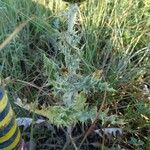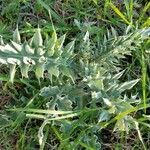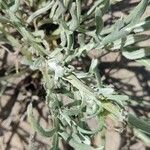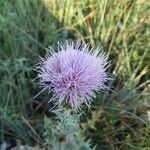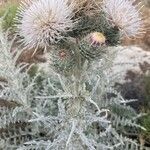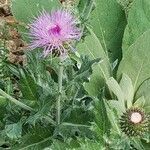Perennials, 20–230 cm; deeply seated runner roots that produce adventitious buds. Stems 1–several, erect or ascending, densely gray-tomentose; branches 0–few, usually above middle, ascending. Leaves: blades elliptic to oblong or ovate, 10–40 × 1–10 cm, margins strongly undulate, coarsely dentate or shallowly to deeply lobed, lobes ascending to spreading, ± triangular, well separated to closely spaced, spinulose and coarsely dentate or usually cleft into 2–3 lanceolate to triangular, often entire-margined, spine-tipped divisions, main spines (yellowish), 2–12+ mm, abaxial densely gray-tomentose, adaxial faces thinly tomentose; basal sometimes present at flowering, winged-petiolate; principal cauline becoming sessile and progressively reduced distally, widest at base, bases ± auriculate-clasping to short-decurrent; distal reduced, spinier. Heads 1–10+, terminal on branches, in leafy, ± corymbiform arrays. Peduncles 0–25+ cm. Involucres ovoid to hemispheric or broadly campanulate, 2.5–4.5 × 1.5–4.5 cm, loosely arachnoid on phyllary margins or glabrate. Phyllaries in 8–12 series, imbricate, ovate to lanceolate (outer) to linear-lanceolate (inner), abaxial faces with prominent glutinous ridge; outer and middle appressed, spines spreading, 1.5–5 mm; apices of inner narrow, often flexuous, flat, ± entire, spineless or weakly spiny. Corollas lavender to pink, purple, or white, 24–50 mm, tubes 12–28 mm, throats 6–14 mm, lobes 6.5–13 mm; style tips 5–7.5 mm. Cypselae light to dark brown, 6–7 mm, bodies and apical collars concolorous, narrow; pappi 20–38 mm (usually scabridulous). 2n = 26.
More
Stout, short-lived perennial from a taproot, this sometimes branching below-ground and producing more than one stem, but without the well developed creeping roots of no. 9 [Cirsium flodmanii (Rydb.) Arthur]; stem 3–12 dm, usually branched above, densely, closely and persistently white-tomentose; lower lf-surfaces similarly tomentose, the upper surfaces more thinly so and sometimes eventually glabrate; lvs coarsely toothed to pinnatifid, the lobes ovate, deltoid, or occasionally oblong, seldom under 7 mm wide; heads mostly several or many, tending to be broadly and shallowly invaginated at the base; invol 2.5–4(–5) cm, its bracts with a glandular-glutinous dorsal ridge and commonly a little marginal tomentum, well imbricate, the inner with attenuate and often crisped tips, the others with spine-tip 3–5 mm; fls pink-purple, sometimes rather pale; achenes 4–7 mm, inconspicuously or not at all banded across the top, becoming mucilaginous when wet (unlike all related spp.); 2n=26. Hillsides, prairies, railroad-tracks, and other open places, in well drained soil; B.C. to Ariz., e. to s. Man., Minn., and Mo., and occasionally intr. eastward. June–Sept. (C. megacephalum)
A herb. It is a thistle. It has a tap root and usually takes 2 years to complete its life cycle but can grow from a few years. The leaves are in a ring near the base and have prickles.
Mixedgrass prairie, shortgrass prairie, Palouse prairie, sagebrush deserts, pinyon-juniper woodlands, openings in montane coniferous forests, often in disturbed areas; at elevations from 100-2,800 metres
More
It is a temperate plant. It grows in dry, well drained open places.
